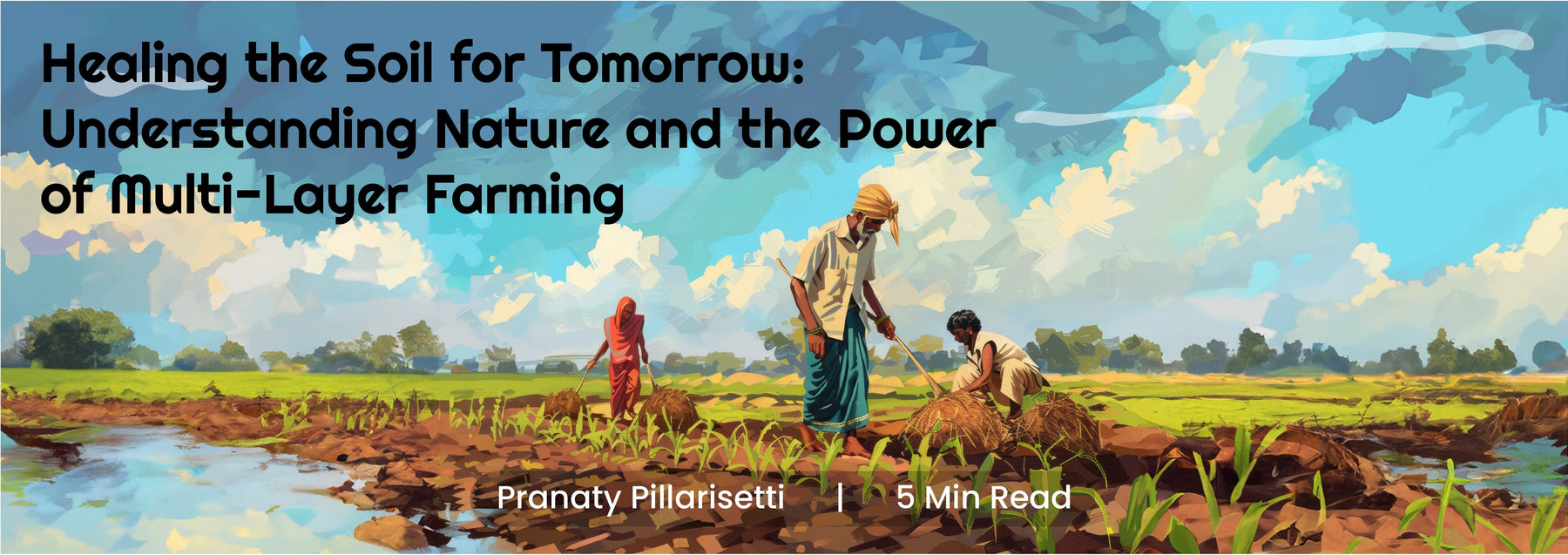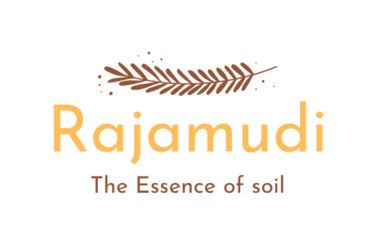
Healing the Soil for Tomorrow: Understanding Nature and the Power of Multi-Layer Farming
Why Organic Certification Takes Years and How Seven-Layer Farming Restores Soil Fertility for Future Generations
There's a quiet tragedy unfolding beneath our feet, one that most of us never see. The soil that once teemed with life, nurtured generations of crops, and supported entire ecosystems has been silenced by decades of chemical farming. What was once a living, breathing organism full of beneficial microbes, earthworms, and nutrients has been reduced to lifeless dust in many places across India and the world.
When we think about the future, we often imagine technological advances, smarter cities, and faster connectivity. But the truth is far simpler and far more urgent: the future depends on soil. Healthy, fertile soil is the foundation of food security, nutrition, and the very survival of future generations. At Rajamudi Organics, we believe that healing the soil isn't just about farming differently, it's about honoring the earth, respecting natural cycles, and committing to a legacy of nourishment rather than depletion.
This is the story of why organic certification takes years, why patience matters, and how multi-layer farming at Rajamudi's Wellness Natural Farms is restoring the soil one season, one layer, one life at a time.
What Decades of Chemicals Have Done to Our Soil
For decades, conventional farming relied on synthetic fertilizers, pesticides, and herbicides to boost yields quickly. It worked for a while. Fields produced more, farmers earned more, and the promise of chemical farming seemed like progress. But beneath the surface, something devastating was happening.
Chemical fertilizers are killing the beneficial bacteria and fungi that naturally enrich soil. Pesticides destroyed earthworms and insects vital to soil aeration and organic matter breakdown. Over time, the soil lost its structure, its ability to retain water, and its capacity to support healthy plant growth. What remained was that they needed more and more chemicals just to produce less and less.
Today, many farms across India are working with soil that has been tortured by chemicals for 20, 30, even 40 years. The topsoil, the most fertile layer, has eroded or become compacted and lifeless. Farmers are trapped in a cycle: more chemicals, higher costs, lower yields, poorer health for both the land and the people who depend on it. This is the reality that organic farming seeks to reverse. But reversing decades of damage doesn't happen overnight. It requires patience, commitment, and a deep understanding of how nature heals.

The Three-Year Journey: Why Organic Certification Takes Time and Patience
When a farmer decides to transition from chemical farming to organic farming, they're making one of the most courageous decisions in agriculture. They're choosing to heal the soil, even though it means facing significant challenges in the first few years.
Organic certification in India, governed by standards like NPOP (National Programme for Organic Production), requires that land be free from synthetic chemicals for at least three years before crops grown on it can be labeled as certified organic. Why three years? Because that's how long it takes for soil to detoxify, for microbial life to return, for the natural balance to be restored.
During these 3-4 years, called the transition period, farmers face lower yields. The soil is still recovering. The beneficial organisms are slowly repopulating. Natural pest control systems are being re-established. Crops may be smaller, more vulnerable, and harder to sell because they can't yet carry the "organic" label. For many farmers, this period tests their resolve and their finances. They're investing in the future while struggling in the present.
At Rajamudi Organics (www.rajamudi.com), we support farmers through this difficult transition, helping them navigate the certification process, providing guidance on soil fertility management, and ensuring they're not alone in their journey toward sustainable agriculture. We believe that this patience, this willingness to wait for the soil to heal, is one of the most powerful acts of care we can offer future generations.
What is Multi-Layer Farming?
Nature never farms in monoculture. Walk through any forest, and you'll see layers like tall trees providing canopy, mid-sized shrubs creating shelter, ground covers protecting the soil, vines climbing toward sunlight, and roots anchoring everything together. Each layer supports the others. Nutrients cycle naturally. Water is conserved. Biodiversity thrives.
Multi-layer farming, also called polyculture or intercropping, mimics this natural design. Instead of planting a single crop across large fields, farmers grow multiple crops in different layers that include long-term trees, medium-term plants, short-term crops, ground covers, vines, and root vegetables, all coexisting in the same space.
This approach offers extraordinary benefits. It maximizes land use, ensuring that every square foot contributes to productivity. It enhances soil health by maintaining constant ground cover, preventing erosion, and cycling organic matter naturally. It supports biodiversity, inviting beneficial insects, birds, and pollinators that create a balanced ecosystem. It conserves water by reducing evaporation and improving soil moisture retention. And perhaps most importantly, it ensures year-round harvests, providing farmers with diversified income and resilience against crop failures.
At Rajamudi's Wellnest Natural Farms, we practice a seven-layer farming system that brings this philosophy to life. Each layer plays a unique role in healing the soil, supporting the ecosystem, and creating a farm that works with nature, not against it.
Inside Rajamudi's Seven-Layer Farming System: A Living Ecosystem
Walking through our farm is like stepping into a living classroom where every plant has a purpose, every layer has a role, and everything coexists in harmony. Let us take you through each of the seven layers and show you;
The First Layer: Long-Term Trees - These are the giants of the farm, the trees that will stand for decades. We grow large trees like coconut, neem, subabul, teak, mango, mahua, Indian gooseberry, chakrota (pomelo), bel, kadamb, jackfruit, ramphal, and sita ashok. These trees have lifespans ranging from 20 to 55 years or more. A mango tree, for example, begins fruiting after four to five years and continues producing for up to 50 years. These trees provide deep root systems that break up compacted soil, draw nutrients from lower layers, and create habitat for birds and beneficial insects. They also offer shade, windbreaks, and long-term economic stability.
The Second Layer: Mid-Term Trees - Below the canopy of the tallest trees, we plant mid-term species like lemon, sweet lime, custard apple, cheeku (sapota), guava, moringa, apple, avocado, glycedia, and subabul. These trees have lifespans of 10 to 15 years and begin producing within a few years. Teak, for example, matures in 10 to 12 years and can be harvested for timber, providing farmers with valuable income. This layer fills the vertical space efficiently and contributes organic matter through leaf litter, enriching the soil continuously.
The Third Layer: Climbers and Medicinal Plants - The third layer introduces vining plants and medicinal species like black pepper, betel leaf, giloy, shatavari, and other traditional medicinal plants. These climbers use the support of the larger trees, requiring no additional land while adding biodiversity and value. Pepper vines, for instance, can grow alongside long-term trees, producing for many years and contributing to the farm's medicinal plant portfolio.

The Fourth Layer: Short-Term Crops - This layer focuses on crops like banana, papaya, tapioca, and castor, which have lifespans of just one to two years. Banana plants, for example, fruit within a year and are then cut down, their biomass returning to the soil as organic matter. Papaya similarly produces quickly and enriches the soil as it decomposes. These crops provide fast returns and constant ground cover, preventing erosion and maintaining soil moisture.
The Fifth Layer: Ground-Level Vegetables and Grains - The fifth layer is where we grow rice, wheat, millets, vetiver, lemon grass, and perennial vegetables. These crops are rotated seasonally, ensuring the soil is never left bare. We also plant medicinal herbs and vegetables like cherry tomatoes, okra, mustard, jeera (cumin), fennel, and flax seeds. This layer is critical for soil fertility because it maintains living roots in the soil year-round, feeding soil microbes and building organic matter.
The Sixth Layer: Fodder and Ground Cover - In the sixth layer, we grow alfalfa, aloe vera, safed musli, stevia, moong (green gram), urad (black gram), horse gram, Bengal gram, and other legumes. These plants serve dual purposes: they provide fodder for livestock and fix nitrogen in the soil, naturally fertilizing the land. Legumes are particularly valuable because their root nodules host bacteria that convert atmospheric nitrogen into a form plants can use, reducing the need for external inputs.
The Seventh Layer: Root Vegetables and Tubers - The deepest layer consists of root crops like turmeric, ginger, elephant yam, sweet potato, safed musli, potato, onion, and garlic. These crops grow underground, utilizing a different soil zone and preventing nutrient competition with surface plants. As they're harvested, their decomposing roots add organic matter deep in the soil profile, improving soil structure and aeration.
This seven-layer system isn't just about productivity, it's about creating a self-sustaining ecosystem where soil health improves year after year. The constant presence of diverse root systems, the continuous addition of organic matter, and the protection from erosion all work together to heal soil that has been damaged by chemicals. You can also Visit our farm - Rajamudi’s Wellnest natural Farm and experience nature living as a weekend getaway from the noise of cities. If you are someone looking for a weekend of fresh air and organic food, do contact us!!
How Multi-Layer Farming Heals and Protects Soil Fertility
Every layer in our farm contributes to soil regeneration. The deep-rooted trees pull nutrients from lower soil layers and bring them to the surface through leaf fall. The ground covers prevent erosion and maintain moisture. The nitrogen-fixing legumes enrich the soil naturally. The decomposing plant matter feeds earthworms, fungi, and beneficial bacteria that create humus - the dark, nutrient-rich component of healthy soil.

This system also conserves water brilliantly. The tree canopy reduces evaporation. The ground cover slows runoff. The organic matter in the soil acts like a sponge, holding water and releasing it slowly to plant roots. Even during dry periods, the soil remains moist and productive.
Perhaps most importantly, multi-layer farming creates resilience. If one crop fails, others succeed. If pests attack one species, the biodiversity of the farm ensures that beneficial predators keep them in check. The farm becomes a balanced ecosystem that can adapt, heal, and thrive without constant human intervention.
Building a Legacy for Tomorrow
At Rajamudi Organics, we're healing the earth and building a legacy. Every decision we make, from supporting farmers through the organic certification process to practicing seven-layer farming at Wellnest Natural Farms, is rooted in the belief that the soil we care for today will nourish generations to come.
Choosing organic isn't just about avoiding chemicals. It's about saying yes to life, to the earthworms that aerate the soil, to the bees that pollinate our crops, to the farmers who work with patience and love, and to the children who will inherit the land we leave behind.
The journey to heal soil takes time. It requires faith, commitment, and a willingness to work with nature's rhythms rather than against them. But the reward is fertile, living soil that produces nutrient-dense food, supports biodiversity, and sustains life and is worth every moment of patience.
We invite you to be part of this journey. When you choose Rajamudi Organics , you're choosing more than certified organic products. You're choosing to support farmers who are healing the soil. You're choosing to invest in a future where the earth can still nourish, sustain, and thrive.
Because the soil we heal today is the legacy we leave tomorrow. Choose Wise, Choose Green & do not forget to Visit Our Farm!!

